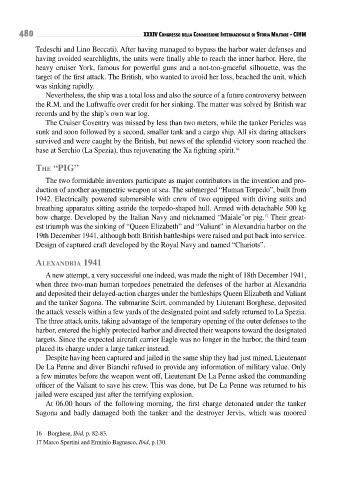Page 480 - Conflitti Militari e Popolazioni Civili - Tomo I
P. 480
480 XXXIV Congresso della CommIssIone InternazIonale dI storIa mIlItare • CIHm
Tedeschi and Lino Beccati). After having managed to bypass the harbor water defenses and
having avoided searchlights, the units were finally able to reach the inner harbor. Here, the
heavy cruiser York, famous for powerful guns and a not-too-graceful silhouette, was the
target of the first attack. The British, who wanted to avoid her loss, beached the unit, which
was sinking rapidly.
Nevertheless, the ship was a total loss and also the source of a future controversy between
the R.M. and the Luftwaffe over credit for her sinking. The matter was solved by British war
records and by the ship’s own war log.
The Cruiser Coventry was missed by less than two meters, while the tanker Pericles was
sunk and soon followed by a second, smaller tank and a cargo ship. All six daring attackers
survived and were caught by the British, but news of the splendid victory soon reached the
base at Serchio (La Spezia), thus rejuvenating the Xa fighting spirit. 16
the “Pig”
The two formidable inventors participate as major contributors in the invention and pro-
duction of another asymmetric weapon at sea. The submerged “Human Torpedo”, built from
1942. Electrically powered submersible with crew of two equipped with diving suits and
breathing apparatus sitting astride the torpedo-shaped hull. Armed with detachable 500 kg
bow charge. Developed by the Italian Navy and nicknamed “Maiale”or pig. their great-
17
est triumph was the sinking of “Queen Elizabeth” and “Valiant” in Alexandria harbor on the
19th December 1941, although both British battleships were raised and put back into service.
Design of captured craft developed by the Royal Navy and named “Chariots”.
aleXandria 1941
A new attempt, a very successful one indeed, was made the night of 18th December 1941,
when three two-man human torpedoes penetrated the defenses of the harbor at Alexandria
and deposited their delayed-action charges under the battleships Queen Elizabeth and Valiant
and the tanker Sagona. The submarine Scirt, commanded by Liutenant Borghese, deposited
the attack vessels within a few yards of the designated point and safely returned to La Spezia.
The three attack units, taking advantage of the temporary opening of the outer defenses to the
harbor, entered the highly protected harbor and directed their weapons toward the designated
targets. Since the expected aircraft carrier Eagle was no longer in the harbor, the third team
placed its charge under a large tanker instead.
Despite having been captured and jailed in the same ship they had just mined, Lieutenant
De La Penne and diver Bianchi refused to provide any information of military value. Only
a few minutes before the weapon went off, Lieutenant De La Penne asked the commanding
officer of the Valiant to save his crew. This was done, but De La Penne was returned to his
jailed were escaped just after the terrifying explosion.
At 06.00 hours of the following morning, the first charge detonated under the tanker
Sagona and badly damaged both the tanker and the destroyer Jervis, which was moored
16 Borghese, Ibid, p. 82-83.
17 Marco Spertini and Erminio Bagnasco, Ibid, p.130.

